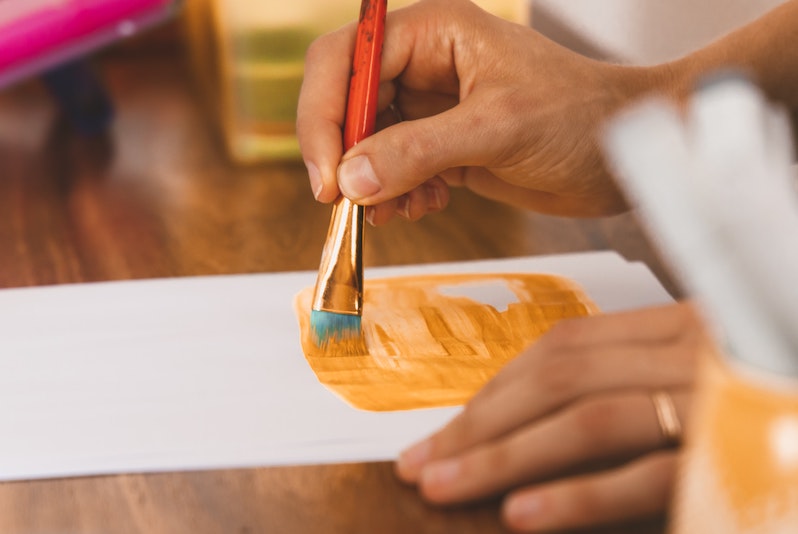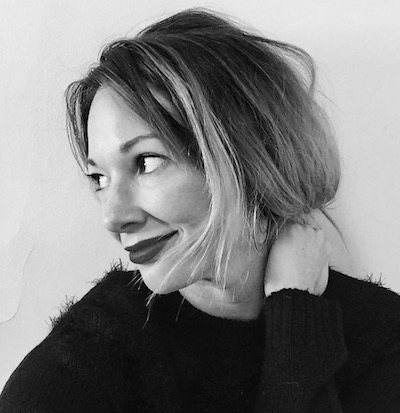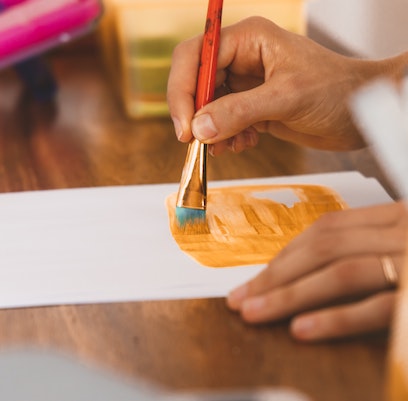
Art has the power to connect, inspire, and heal us. Not only does creating our very own art allow for meaningful self-expression, but studies show that it can also help in treating depression, anxiety, and post-traumatic stress disorder.
Whether it’s sketching, painting, making collages, sculpting with clay, or whatever other form of creative expression floats your boat, making art can actually make us happier. And guess what? It doesn’t even have to be good. Yep, you can fully express yourself, process feelings, develop self-awareness, boost self-esteem, and release stress, regardless of artistic experience or talent.
I’m a big believer in painting when I’m overwhelmed. I can feel my body start to relax as soon as I set out my down and dirty set of acrylics and brushes. Sure, the end product isn’t that great, but I always feel better for having done it. It’s not a hustle, and it’s not something that relies on external validation. It’s just my bad art that I made simply for the sake of creating something.
Since making perfectly imperfect art has been such a healing practice for me, I wanted to talk to an art therapist about the power of artistic expression and how everyone can get started. Read on for how to give your mental health a creative boost.
Top tips from an art therapist
“Making art is all about the process, not the product, so I want to debunk the idea that you need to be an artist to experience the benefits of artistic expression,” shares Nicole Lee, art therapist, LCAT, ATR-BC, RYT. “To me, being in flow with creativity means that we’re connecting with the materials and ourselves. It doesn’t need to be good or perfect. And it can even be something we did not expect.”
“Art is all about exploration, and not just creating a piece that looks a certain way. We want to have creative freedom so that we can access parts of ourselves that maybe we haven’t before.”
Start by picking materials that feel good for you.
Lee recommends picking materials that feel manageable and attainable to avoid feeling overwhelmed. “Maybe you’ve had a good experience with colored pencils or magazine cutouts, so that’s a good place to start,” Lee said. “Pick one to three materials and a half sheet of paper or a small canvas.”
Create a soothing environment.
She also suggests creating art in a space that feels safe and supportive for you. “I love to light a candle or incense, and put on a calming playlist,” added Lee.
Set an intention.
“I like to start with an intention with my clients so that we have some guidelines to work within. Maybe your intention is to decrease stress, or to be more mindful. Do you have an object or theme in mind, or do you want to be more open-based?”
A simple way to start is picking 2 or 3 colors you want to work with, or choosing an image as inspiration. It could be of a meadow, an animal — whatever helps you feel calm, centered, and at ease.
Then, take a few minutes with your intention, take some deep breaths in and out (here’s a quick meditation if you’d like a little guidance), and start putting lines, shapes, or colors onto the paper.
Quiet the inner critic.
If you experience regular feelings of self-doubt, this can be a great way to introduce the concept of lowering your expectations. “Everyone’s self-talk is different. Sometimes it’s best to push through, and sometimes it may be too much for people. If you start to get overwhelmed and it feels unsafe, it’s okay to stop and switch things up to make yourself feel better. You don’t need to be Picasso to make art, but it is important to be aware of what your limits are.”
“Art is all about exploration, but it’s also a direct link to our psyche and we should treat that with gentle care and kindness. If creating art brings up feelings that make you feel unstable, be sure to reach out to a mental health specialist.”
And, if you’d like a little help quieting the inner critic, we have a meditation for you.
Start simple.
“We want to create art that feels manageable. Maybe you just start by putting marks on the paper. Maybe you draw triangles and root them to the ground.”
Try giving yourself a time period to create. You can start with five or ten minutes, and if you go over, that’s great.
“How long it takes to make a piece or how much we fill up the page is not necessarily the objective for mindfulness based art making,” said Lee. “You decided to carve out time for yourself to create and be present with your materials, let’s appreciate that shift in your day and go from there. When we lower our expectations it can make it more fun and joyful.”
If you think you’re ready to dive into creative exploration, try to keep your focus on the process and not the final product. Humans are innately creative, expressive beings, so all you need is a willingness to experiment.
If what we’ve discussed doesn’t quite feel right for you, don’t forget that there are many forms of creative therapies, including dance therapy, drama therapy, music therapy, and writing therapy. And if you’re interested in working with an art therapist, consider searching the Art Therapy Credentials Board website.
Feeling inspired? Drop into our community and share what’s sparking joy for you right now. We’ll be here to support you as you let your creativity flow.

By Katie Nave, Copywriter at Sanvello
Katie is a writer and mental health advocate living in Brooklyn, New York. Her work has been featured in publications including Newsweek, Glamour, Business Insider, and Motherly. She has served as a producer for the National Women’s March and worked with organizations like Girls Inc. and CancerCare. She is currently the Copywriter at Sanvello and you can follow her on Instagram: @kathryn.e.nave.
